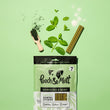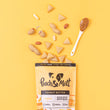
FREE UK DELIVERY ON ORDERS OVER £39.99
At times, bringing a new pup home can be comparable to having a baby. There is a lot of hard work and commitment involved. With unsettled nights and lots of poo; a new owner can find their hand suddenly very full. The work put in in the first few weeks and months can have a lasting impact and it is important to set your furry friend up for success.
Of all the things we need to teach our little fur balls, there are three ‘basics’. When we get this right, a lot of stress will be lifted from our lives. Read on to discover how you can ace your puppy's training:
For many, having a puppy who pees and poos outside is a real focus of their training in the early weeks. Smaller breeds will typically take longer to house train and some accidents are expected up until about 4 or 5 months of age. It is unrealistic to expect a small puppy to be fully house-trained within a matter of weeks (though some clever critters may take to it like the proverbial duck to water).
Consistency is key. It may seem like over-kill but we need to take our pups outside to pee all the time. As soon as they wake up in the morning, after every nap, every drink of water and every meal we should be putting them out to their ‘pee spot’. Use the same spot every time and a command such as ‘Get busy!’ or 'Toilet'.
Do not underestimate the importance of a treat when your dog gets it right. Each time they toilet outside they should get an immediate ‘Yes!’ and a yummy snack. I would recommend any of our Meaty Treats as puppies love the taste. This type of training is called ‘positive reinforcement training’. We are encouraging good behaviour with words of encouragement and a small, delicious bribe.
Importantly, we must never reprimand for toileting inside. Them toileting inside simply means we didn’t read their body language and didn’t offer enough opportunity to toilet outside. Gone are the days when it was advised to ‘rub your dog’s nose in their mess’ as this can lead to anxiety and behavioural issues.
Should I wake my puppy up to pee at night?
Young puppies don’t have the bladder control to go through the whole night without needing the toilet, there are a few things you can do to help reduce the amount of times they need to pee through the night such as removing their water bowl an hour before bedtime to ensure they aren’t filling their bladder. As well as this, make sure you take your pup outside as late as possible before you go to bed yourself to get them into the routine of going to the toilet before bedtime. Your puppy won’t want to go to the toilet where they sleep, so will usually wake you up when they need the toilet or once they have been. Once you have established their toilet routine through the night, start to set your alarm 10-15 minutes before they usually wake, so you can wake them up to take them outside before they go to the toilet in their crate or pen. You can also start by setting your alarm 4 hours after your puppy goes to bed, if this is too long and your puppy has an accident, reduce your alarm time until you are waking your puppy up to go to the toilet just before they would wake themselves. As your puppy gets older, you can gradually extend the time between toilet breaks until your puppy is old enough to go through the night.
Whether or not you wish to crate train is a personal preference. I am personally a big fan as crates act as a ‘sanctuary’ for your pet and are their own ‘safe space’ where they can take themselves for some time alone. They are also really useful for when we need to leave the home but the puppy is too small to be left out unsupervised. Similarly, it is handy to pop your puppy in their crate if there are guests over who do not like dogs. For many, the crate is used as a place to sleep for the duration of a dog’s life.
We must never rush into crate training. Too often an owner will tell me their puppy is ‘fully crate trained but sometimes cries when left in the crate’. This is not a crate trained pooch! Once crate-trained, the crate should be fully accepted and dogs will be happy to stay inside.
Start off very slowly; letting your pup walk in themselves and leaving the door open. Have some tasty treats inside the crate and perhaps a favourite toy. Once this is tolerated, work up to closing the gate and eventually leaving your pup for a minute or two.
*If your pup barks or become distressed, they have been left for too long.*
Though it will take time to work up to leaving puppy alone for a few hours, it will be worth it in the end.
Puppies need a lot of sleep, they expend energy training, zooming around, socialising, growing and developing muscles etc, then need lots of sleep to recover. This should be in the form of regular naps throughout the day and longer stretches through the night. There is no rule for how much you should let your puppy sleep, every puppy has different environment, schedules and needs but remember puppies grow much quicker than adult dogs and need lots of sleep to help support that growth.
While puppies are MUCH easier to get to sleep than babies, mastering over-night sleep is not always that easy. We won’t have to play white noise or rock our puppies (though perhaps some would enjoy that!) but we do need to provide a suitable sleep environment.
A crate works well. In lieu of this, a cosy bed in a quiet part of the house should be accepted. It is your choice if you want your pup in your room or not. Remember though, they will still want to sleep there when a fully-grown, slobbery adult.
Try to implement a routine whereby you have plenty of exercise before bedtime and set bedtime for a similar time each night. Try to keep the room quiet and dark; stimulation must be kept to a minimum. Similarly, try to have a consistent ‘morning time’ by offering breakfast at the same time each day. Dogs are real creatures of habit.
In the early days, be sure to let your dog out to toilet if they need to. Similarly, they may need a drink of water. However, as a dog matures, they should not need anything overnight.
Top Tip: When crate training for over-night sleeps, use our Turkey & Hemp calming treats to help your little one wind down. The hemp in these treats may help relieve anxiety and promote restfulness. An ‘Adaptil’ plug in can also be used beside the crate to release calming pheromones.



Comments (2)
this info on puppy training was very useful. I do have another problem you may be able to help with and that is biting, our puppy is 12 weeks old and continues to bite when excited. What can we do?
Hi Margaret, it sounds like your puppy could be teething and we did a recent blog post on this, if you take a look in our “Puppy” section on blog posts. Teething puppies will naturally bite whatever they can get their little snouts on, including your skin. Why not take advantage of this early stage of their development to teach ‘bite inhibition’? This means when they bite too hard, firmly say ‘no’. If they continue, remove yourself from their presence. When they learn to stop biting on demand, reward them with a treat. Eventually, they should learn to never bite so hard that it causes harm to other dogs or humans, even when significantly stressed :)
Leave a comment